Macrame, the ancient art of knotting cords to create intricate patterns and designs, has witnessed a resurgence in popularity as a modern craft form.
While traditional macrame projects utilize specialized cords or ropes, many enthusiasts wonder whether an everyday item can be repurposed for their creative endeavors.
One such item is the humble cotton clothesline. This versatile material, typically used for laundry, can be a cost-effective and accessible alternative for macrame projects, provided it meets certain essential criteria.
In this exploration, we delve into the feasibility of using a cotton clothesline for macrame and offer guidance on selecting, preparing, and utilizing this unexpected medium in your creative pursuits.
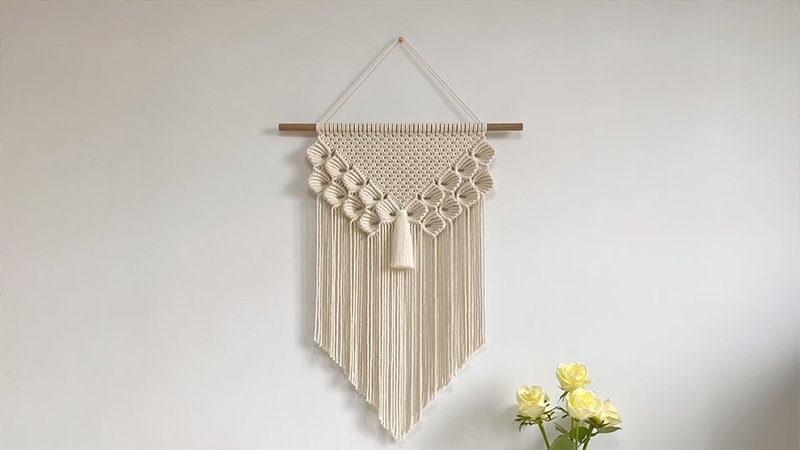
Can You Use Cotton Clothes Line for Macrame?
Certainly, you can use a cotton clothesline for macrame projects. macrame is a versatile craft that involves creating decorative items by tying various knots in cords or strings.
While many macrame projects traditionally use cotton cord or rope, a cotton clothesline can serve as a suitable alternative, provided it meets certain criteria.
Here are some key points to consider when using a cotton clothesline for macrame:
Material
When selecting a cotton clothesline for macrame, it’s crucial to confirm that it’s made of 100% cotton. Natural cotton fibers are known for their softness, pliability, and ability to hold knots securely.
Avoid clotheslines made of synthetic materials like nylon or polyester, as they lack the texture and knot-holding properties of cotton.
Diameter
The diameter of the clothesline is an essential consideration.
Thinner cotton clotheslines, typically in the 1/8 to 1/4 inch (3-6mm) range, are ideal for intricate and delicate macrame projects such as jewelry, whereas thicker ones (around 1/4 inch or larger) are better suited for larger, more robust designs like plant hangers or wall hangings. Your choice should align with the scale of your project.
Color
Cotton clotheslines are available in a range of colors. The color you select depends on your project’s aesthetic.
Natural, unbleached cotton provides a neutral and organic look that’s popular for many macrame pieces, but you can also choose colorful options to match your design vision.
Strength
Ensure that the cotton clothesline you select is strong enough to support the weight of your macrame project. For items like plant hangers or wall hangings, durability is important.
Thicker and more robust clotheslines will generally be stronger and better suited for weight-bearing purposes.
Preparation
Before starting your macrame project, it’s a good practice to prepare the cotton clothesline. Wash it gently and iron it to remove any kinks, wrinkles, or residual manufacturing chemicals. A clean and straight cord will make it easier to work with and create neat, even knots.
Knots
The essence of macrame is the art of tying knots. A cotton clothesline is well-suited for this purpose, as its texture ensures that knots hold securely.
Depending on your project, you’ll use various macrame knots like square knots, half-hitch knots, or lark’s head knots. Cotton’s grip is excellent for crafting these knots.
Safety
Be vigilant about the ends of your cotton clothesline. Over time, the fibers at the ends may fray or unravel, which can make your work less tidy and secure.
To prevent this, you can wrap the ends with masking tape, apply a small amount of clear nail polish, or tie a knot at the tip. This secures the ends and prevents fraying, ensuring a neater and more stable macrame piece.
How to Use Cotton Clothes Line for Macrame? 8 Steps
Using a cotton clothesline for macrame is a practical and cost-effective choice for your creative projects.
Follow these steps to effectively use a cotton clothesline in your macrame endeavors:
Materials You’ll Need:
- Cotton clothesline of the desired diameter and length.
- Scissors to cut the clothesline.
- A work surface to create your macrame design.
- A tape measure or ruler to measure and cut the clothesline accurately.
- Masking tape or clear nail polish to prevent fraying at the ends.
Step 1: Prepare Your Cotton Clothesline
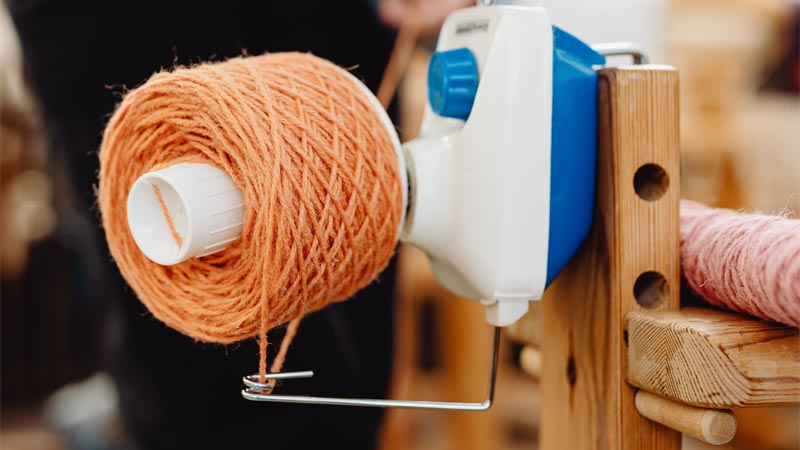
Begin by washing and ironing the cotton clothesline to remove any kinks or wrinkles. This step ensures that the cord is clean, straight, and easier to work with.
Step 2: Measure and Cut
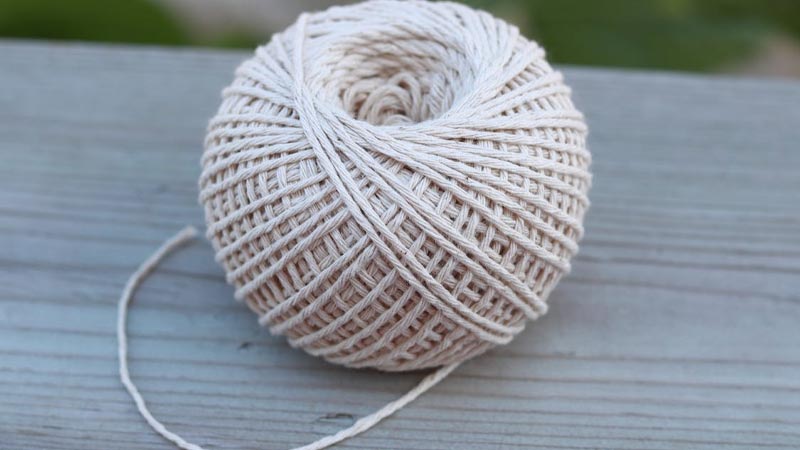
Measure the length of the cotton clothesline you need for your specific macrame project and use scissors to cut it to the desired length. Ensure the cuts are clean and straight.
Step 3: Start Your Knots
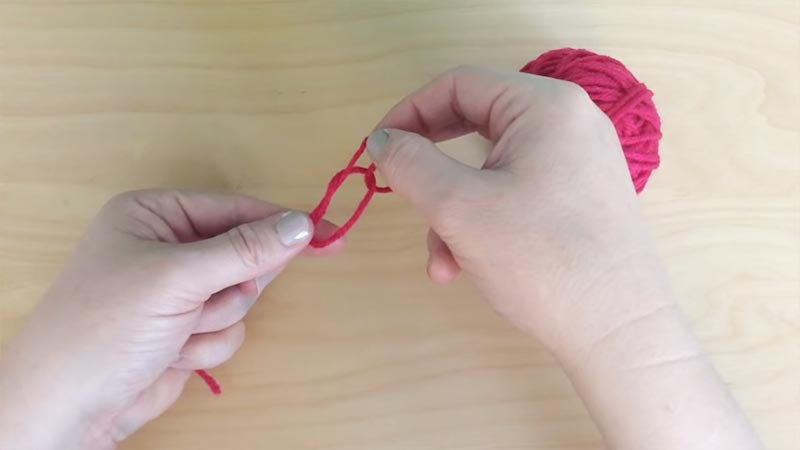
Begin your macrame project by securing one end of the cotton clothesline to your work surface. You can use a simple knot or tape to keep it in place. This serves as the starting point for your design.
Step 4: Tie Knots
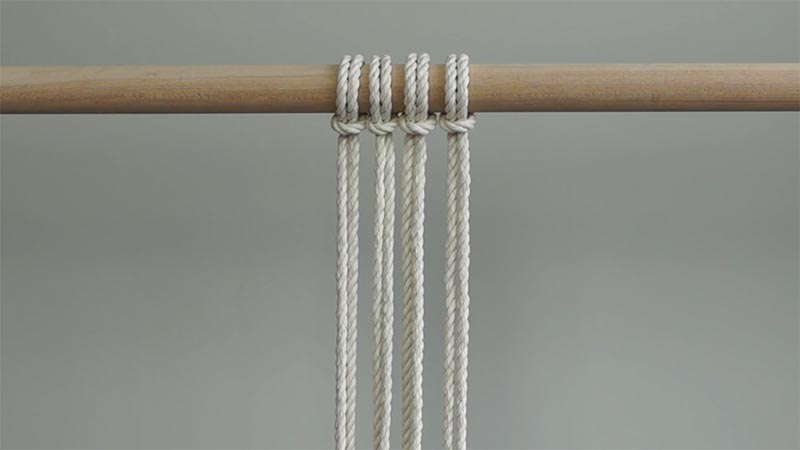
Use your cotton clothesline to create various macramé knots, depending on your project’s pattern. Common knots include the square knot, half-hitch knot, lark’s head knot, and more. Follow the instructions of your chosen macramé pattern or design to create the desired knots.
Step 5: Maintain Tension
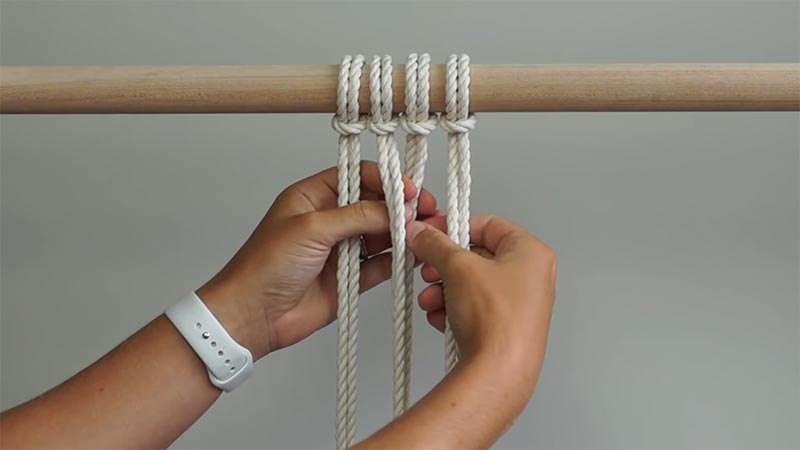
Keep consistent tension on the cotton clothesline as you work to ensure that your knots are even and secure. Tension is vital to maintain a uniform appearance in your macrame piece.
Step 6: Complete Your Design
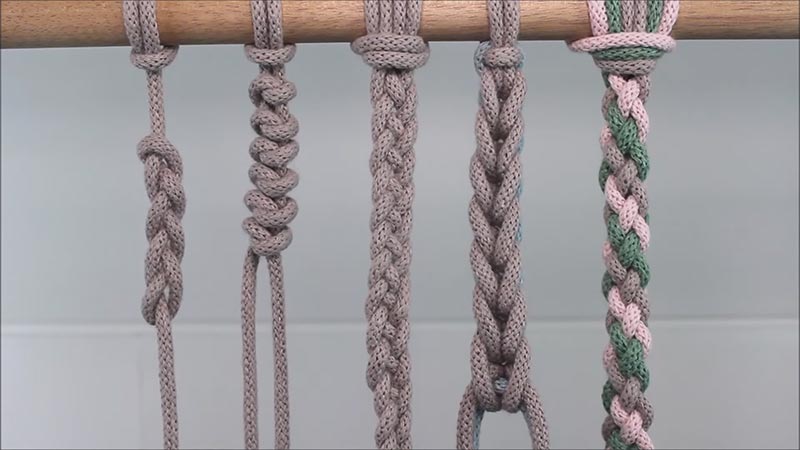
Continue tying knots and working with the cotton clothesline until you’ve completed your macrame design.
You can create wall hangings, plant hangers, keychains, or various decorative items, depending on your creativity and the project’s requirements.
Step 7: Finishing Touches
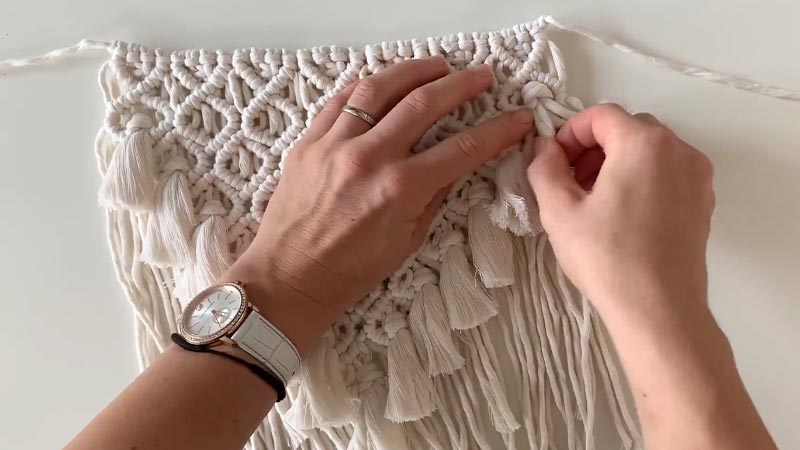
Once your design is complete, secure the final knots. Trim any excess cord, and use masking tape or clear nail polish to prevent fraying at the ends. This step ensures the longevity and neatness of your macrame creation.
Step 8: Hanging or Using Your macrame
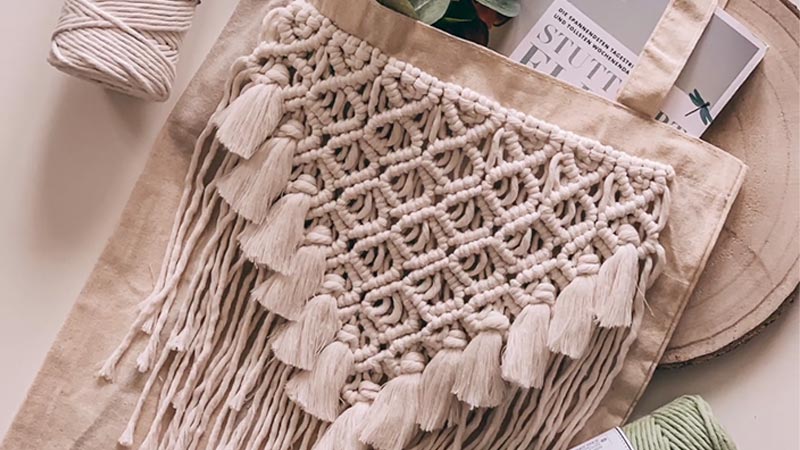
Depending on the project, you can attach hooks, rings, or other hardware for hanging your macrame piece.
Alternatively, you can incorporate it into your home decor or use it as intended, whether it’s a plant hanger, wall art, or another functional item.
Advantages of Using Cotton Clothes Line for Macrame
Using cotton clothesline for macramé offers several advantages for crafters and DIY enthusiasts.
Here are some of the benefits of using cotton clothesline for your macramé projects:
Cost-Effective
Cotton clothesline is readily available and often more affordable than specialized macramé cords or ropes.
This makes it an excellent choice for beginners or anyone looking to create macramé projects without a significant upfront investment.
Readily Available
You can find cotton clotheslines in most hardware or home improvement stores, making it easily accessible for your macramé projects. There’s no need to search for specialized craft supplies.
Versatility
Cotton clothesline comes in various diameters, allowing you to choose the thickness that suits your project.
You can use thinner lines for delicate jewelry or thicker ones for substantial items like plant hangers or wall hangings.
Texture and Grip
Cotton’s natural texture provides excellent grip for holding knots securely. This ensures that your macramé knots won’t slip or unravel easily, resulting in a more stable and attractive finished product.
Durability
Cotton is a durable material, especially when compared to synthetic alternatives. It can withstand wear and tear, making it suitable for long-lasting macramé creations.
Color Options
Cotton clothesline is available in various colors, allowing you to choose the perfect shade to complement your design. You can also use natural, unbleached cotton for a neutral, organic look.
Customization
You can easily dye or paint cotton clothesline to achieve the exact color you desire for your macramé project. This level of customization is not as straightforward with some specialized macramé cords.
Ease of Knotting
The cotton clothesline holds knots well, making it user-friendly for both beginners and experienced macramé enthusiasts. It allows for a smooth and enjoyable crafting experience.
Environmentally Friendly
Cotton is a natural, biodegradable material, making it an eco-friendly choice for crafting. It’s a sustainable option that aligns with modern environmental concerns.
Widely Accepted Techniques
Many macramé patterns and tutorials are designed for cotton cords and ropes. By using a cotton clothesline, you can easily follow these instructions and create intricate designs.
Custom Length
You can cut cotton clotheslines to your desired length for each project, reducing waste and ensuring you have exactly what you need.
Disadvantages of Using Cotton Clothes Line for Macrame
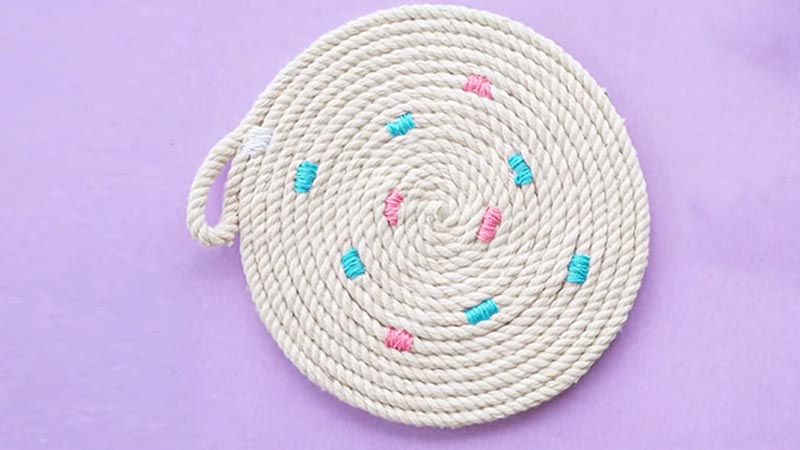
While cotton clothesline can be a practical and cost-effective choice for macramé, it also comes with certain disadvantages that you should consider for your crafting projects.
Here are the most common disadvantages of using cotton clothesline for macrame:
Limited Diameter Options
Cotton clothesline typically comes in limited diameter options compared to specialized macramé cords. This limitation may not be suitable for intricate or very fine macramé projects.
Kinkiness
Cotton clothesline can be prone to kinking or twisting, which may affect the overall appearance of your macramé piece. You will need to spend extra time preparing the cord to eliminate kinks.
Inconsistencies in Quality
The quality of cotton clotheslines can vary between brands and manufacturers. Some may have inconsistencies in texture or thickness, which can be frustrating when working on detailed macramé patterns.
Limited Color Range
While cotton clothesline comes in various colors, the range is still more limited compared to specialized macramé cords, which offer a broader spectrum of shades and textures.
Fraying
Cotton clothesline, especially at the ends, is prone to fraying over time. You’ll need to take extra steps, such as applying clear nail polish or tape, to prevent fraying and maintain the cord’s integrity.
Not Ideal for All Designs
The texture and thickness of cotton clothesline may not be suitable for all macramé designs. Some intricate or delicate patterns may require a more specialized cord to achieve the desired results.
Lack of Variety in Material
The cotton clothesline is made solely from cotton. Specialized macramé cords offer a variety of materials, such as jute or nylon, which can provide different textures and appearances for your projects.
May Not Meet Load-Bearing Requirements
For macramé projects intended to bear significant weight, such as large plant hangers or wall hangings, cotton clothesline may not be as strong as specialized cords designed for such purposes.
Environmental Concerns
While cotton is a natural material, the cotton industry has its own environmental concerns, including water usage and pesticide use. If sustainability is a primary concern, you may want to explore alternative materials.
Difficulty in Dyeing
While cotton clotheslines can be dyed, achieving consistent and vibrant colors may be more challenging compared to specialized cords that are designed for easy customization.
Tips for Using Cotton Clothes Line for Macrame
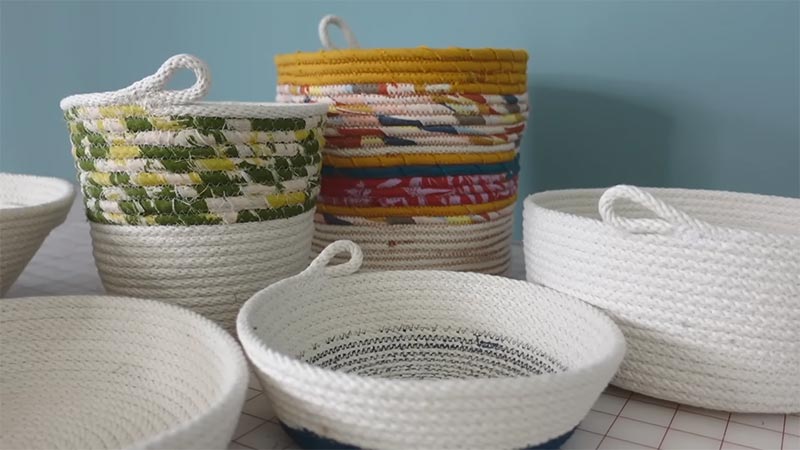
Using cotton clothesline for macramé can be a rewarding experience when you follow these tips to make the most of this versatile and budget-friendly material:
Choose the Right Diameter
Select a cotton clothesline with a diameter that matches your project’s requirements. Thicker cords work well for larger projects like plant hangers, while thinner ones are suitable for delicate jewelry or intricate patterns.
Preparation Matters
Before starting your macramé project, wash and iron the cotton clothesline to remove kinks and wrinkles. A clean, straight cord will be easier to work with and result in a neater finished product.
Secure the Ends
To prevent fraying, secure the ends of the cotton clothesline with masking tape or clear nail polish. This ensures that your cord remains intact throughout your macramé project.
Work with Tension
Consistent tension is crucial in macramé to create uniform and professional-looking knots. Maintain even pressure on the cord as you work to ensure your project’s stability and appearance.
Practice Knots
Familiarize yourself with various macramé knots such as square knots, half-hitch knots, lark’s head knots, and more.
Practice these knots on a small piece of cord to build your skill and confidence before starting your main project.
Use Patterns and Tutorials
Macramé patterns and tutorials designed for cotton cords can provide valuable guidance for your projects. These resources can help you learn new techniques and create beautiful designs.
Experiment with Dye
If you can’t find the perfect color for your project, consider dyeing the cotton clothesline. Follow dyeing instructions for cotton materials and ensure the cord is completely dry before starting your macramé.
Plan Your Project
Before diving into your macramé project, plan out your design, including measurements and knot placements. This can save you time and reduce the risk of errors during the process.
Check Consistency
Be aware of potential variations in quality when using different brands of cotton clothesline. Check the cord’s thickness, texture, and color consistency, especially when working on intricate patterns where evenness is essential.
Seek Inspiration
Explore macramé designs and projects online or in books to gain inspiration for your own creations. Adapting existing patterns can be a great way to start your macramé journey.
Patience and Practice
Macramé is a craft that improves with practice. Be patient with yourself and don’t get discouraged if your first projects don’t turn out as you imagined. Learning from mistakes and continuing to practice will enhance your skills.
Finishing Techniques
Once your macramé project is complete, use appropriate finishing techniques to secure the knots and trim any excess cord. This ensures a professional and polished appearance.
Frequently Asked Questions
Can I use a recycled cotton clothesline for macramé?
Yes, you can repurpose old cotton clotheslines for your macramé projects. Ensure it’s clean and free from any damage or wear, and you’re ready to create eco-friendly macramé pieces.
How do I add color to a natural cotton clothesline for macramé?
You can dye cotton clothesline using fabric dye or paint. Follow the dyeing instructions specific to cotton materials to achieve the desired color for your project.
Is it possible to combine different diameters of cotton clotheslines in a single macramé project?
Yes, you can combine various diameters to add dimension and texture to your macramé design. Just ensure that the knots and tension are consistent for a polished look.
Can I use a cotton clothesline for outdoor macramé projects?
While cotton clothesline can be used for outdoor projects, it’s essential to protect it from prolonged exposure to the elements as cotton may not be as weather-resistant as some other materials.
Last Words
The use of cotton clotheslines for macramé projects offers a cost-effective and accessible avenue for creative expression.
Its versatility, availability, and natural texture make it a favorable choice for a wide range of macramé designs.
Whether you’re a novice or an experienced crafter, the simplicity of cotton clothesline allows for the exploration of intricate patterns and unique pieces.
While it comes with certain limitations, such as diameter options and potential kinking, these challenges can be mitigated with preparation and practice.
Embracing cotton clotheslines in macramé crafts showcases the beauty of resourcefulness, environmentally conscious choices, and the art of transforming everyday items into stunning works of art.
Leave a Reply